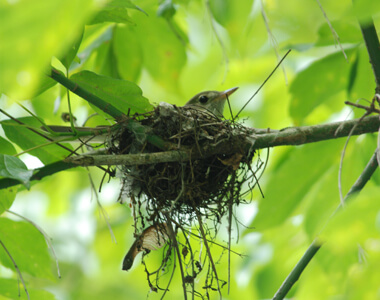Young Birds, Rabbits and Other Newborn Wildlife Easy Prey for Cats


For Immediate Release Contact: Robert Johns, 202-234-7181 ext.210
 |
Acadian Flycatcher. |
BETHESDA, MD — As young birds, rabbits and squirrels venture from their nests in early summer in their usual vulnerable and generally defenseless state, The Wildlife Society (TWS) and American Bird Conservancy (ABC) remind cat owners that even the most well-fed domestic cats pose serious threats to these small and newly born wildlife. At the same time, free-roaming pets also face dangers that can injure or kill them.
“Cats and other predators probably kill more wildlife this time of the year than any other because newborn prey not only don't have any physical defenses but they also have not fully developed the danger awareness regarding predators that comes with time,” said American Bird Conservancy Vice President Mike Parr. “This is the most important time of the year for cat owner's to restrict outdoor activities of their pet,” he said.
“It's also a common misconception that domestic cats can live easily outdoors,” says Michael Hutchins, Ph.D., Executive Director of TWS. “Well-meaning owners often think it's okay to let them roam because cats seem independent by nature. And while they don't always need the same care as dogs, the truth is dramatically different.” Free-roaming or feral cats are at risk of early death or serious injury due to diseases, cars, poisons and predators such as dogs and coyotes. Outdoor cats typically live less than five years, whereas cats kept exclusively indoors can live to be 17 years or older.
TWS biologists have long agreed with colleagues at American Bird Conservancy and state and federal wildlife agencies that domestic cats allowed to roam outdoors have serious, negative impacts on wildlife populations. Even cats that live outdoors part-time pose threats. “Outdoor life is often hard on cats; it's also tough on native wildlife,” said Mike Parr, Vice President of ABC.
Exact numbers are unknown, but scientists estimate that nationwide, cats kill millions of birds and small animals each year including mammals (rabbits, squirrels, small rodents), reptiles (lizards, skinks, salamanders) and amphibians (frogs).
Birds whose natural movements include time on or near the ground are susceptible, especially those that breed or nest on the ground. Typical prey for cats includes robins, cardinals, blue jays, quail, and warblers. In addition, young wildlife are often most vulnerable as they do not have the experience to avoid cats or the ability to quickly escape harm.
“The top cause of declining bird populations is that their natural habitat is being lost to development, Hutchins notes. “Domestic free roaming and feral cats are close behind. It's hard for many cat owners to believe their pets are predators, since we are not usually around to see them in action.”
People often believe that cats won't hunt if they've been well fed. Research shows that cats instinctively hunt, no matter how much they've been fed, because the hunting instinct is independent of the urge to eat.
“People can do something to help native wildlife in their backyard, and it will likely help their pets live longer,” concluded Parr. “We advise cat owners to spay and neuter their pets, and protect them by keeping them indoors, on leashes, or in outdoor enclosures.”
Further information to make it easier to keep pets contented indoors with a minimum of hassle can be found on the ABC website at https://abcbirds.org/program/cats-indoors/.
About The Wildlife Society
TWS is a scientific and educational organization dedicated to enhancing the ability of wildlife professionals to conserve diversity, sustain productivity, and ensure the responsible use of wildlife resources for the benefit of society. TWS also is an advocate for science-based wildlife policy. For more information visit www.wildlife.org
About American Bird Conservancy
American Bird Conservancy (www.abcbirds.org) conserves native birds and their habitats throughout the Americas by safeguarding the rarest species, conserving and restoring habitats, and reducing threats while building capacity of the bird conservation movement. ABC is a 501(c)(3) not-for-profit membership organization that is consistently awarded a top, four-star rating by the independent group, Charity Navigator. For more information visit www.abcbirds.org


















































